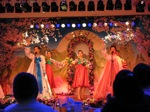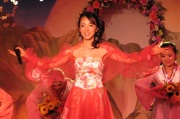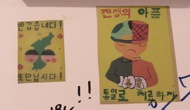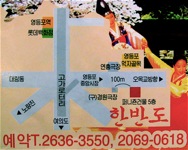After a trip to South Korea’s National Museum this afternoon, a friend of mine took us to a rather unusual new addition to Seoul’s night live. Only a few days ago a restaurant near Yŏngŭngp’o Market station called Hanbando (하반도 평양식 극장식당, ph. 2636-3550) opened with a North Korean theme to it. The interior walls are painted with the blue “united Korea” flag symbol and is painted landscapes from North and South Korea.
 What makes this place special is the fact that is jointly run by South Koreans and North Korean defectors, who make up much of the staff. Waitresses were dressed in characteristically North Korean black and white traditional dress and the climax of the evening came with an on-stage performance by several North Korean dancers and singers. As someone from the management explained to us when we came in, “They once sang for their country, now they are singing for themselves.” They performed various North Korean songs, some of which seemed to be familiar to the audience. The several dozen visitors who were there tonight were mostly middle aged or older but included at least one three generational family complete with grandmother and toddler.
What makes this place special is the fact that is jointly run by South Koreans and North Korean defectors, who make up much of the staff. Waitresses were dressed in characteristically North Korean black and white traditional dress and the climax of the evening came with an on-stage performance by several North Korean dancers and singers. As someone from the management explained to us when we came in, “They once sang for their country, now they are singing for themselves.” They performed various North Korean songs, some of which seemed to be familiar to the audience. The several dozen visitors who were there tonight were mostly middle aged or older but included at least one three generational family complete with grandmother and toddler.

The Performers were led by Kim Hye-yŏng who is apparently well-known in both South Korea and increasingly in Japan since she defected to the South some seven years ago (More here which mentions the restaurant). During the performance my friends enjoyed some North Korean “Schizandra liquor” (오미자술) complete with its “Made in DPR Korea” tag. More than anything about Hanbando, what I find interesting was the complex mix of messages the restaurant gave to its visitors.
On the one hand, a North Korea-themed restaurant, complete with North Korean drinks, food, musical performances, wall paintings, and videos playing with North Koreans dancing seems hard to imagine in South Korea say, a decade ago. Clearly, one of the marketing points of this restaurant is its exotic North Korean experience, complete with genuine North Korean performers who move and speak in ways familiar to anyone who has watched documentaries or news programs about North Korea. The visitors can delight in identifying the North Korean waiters and waitresses by their distinctive accents, or by inspecting the labels on the North Korean products to try to figure out how they got sold in the South Korean market.
However, at the same time the management clearly tried to neutralize many of political elements. Hanbando is no European or American Communist theme bar with their Lenin posters, sickles, hammers, and KGB spy equipment on the walls. Instead, the North Korea of this restaurant is, if anything, portrayed as a repository of authentic Korean, and especially North Korean culture. This is an innocent North Korea, and the light blue images of a united Korea on the walls and upon the white flags that various figures in traditional dress painted on the walls are holding are calling out for everyone to recognize that, “We are one Korea.” Kim Hye-yŏng and another annoying male performer joined together to quiz the audience on their knowledge of North Korean vocabulary, especially on the native words North Korea uses for soccer terminology. This was a “cute” North Korea, an image further contributed to with performances of “cute” dances and traditional songs and the dress of the performers and staff.

The hall leading to the restrooms in the back of the restaurant had one wall with a painting of the joined hands of Kim Daejung and Kim Jŏng-il and a picture of one of the performers between them. The placement of the picture seemed to say that the performers were facilitators of North-South reconciliation. Another wall had a drawing of a Korean split half into a North Korean soldier and the other half a South Korean soldier. On it was written, “Heal the pain of war with unification.” Like the flag and landscape images elsewhere in the restaurant these two images were also supportive of unification, but with a slightly more political flavor to them. South and North soldiers are equated without reference to the horrors of communism. The image of the joined hands of the leaders of North and South is an implicit praise of the sunshine policy. There are no images demanding reform in the North, no paintings showing an oppressed people. The walls seem untouched by those defectors from the North who have turned into strong anti-Communist activists that use every opportunity to plead for reform in the North or the rescue of their oppressed family.
And yet, the visitor would find it difficult to conclude that there is a pro-leftist or pro-North Korea slant here. The waitresses wear North Korean style black and white traditional dress, not unlike the female students of the pro-North Korean schools of Japan. However, if you look closely at their hanbok around the waist area, in a large and clear font there is the Chinese character 韓(한) which is found in the South’s word for Korea, Hanguk but not the Chosŏn used by North Korea. It is as if, instead of Kim Il-sŏng badges declaring their loyalty to the North, all the waitresses are wearing a single Sino-Korean character which declares their allegiance to the South.
That is not all. The last song that Kim Hye-yŏng sang removed any doubt about whether or not she had betrayed North Korea and completely embraced the southern puppets of American imperialism. Her song had a loud and triumphant chorus which repeatedly called out a cheer for South Korea “대한민국 만세” (大韓民國 萬歲) instead of the cheer for unification (“통일 만세”) that we might expect from a North Korean performer. Also, in her concluding speech (which I understood little of and had summarized for me by a Japanese friend of mine who is far more proficient in Korean than I), the defector Kim told the audience that her dancers and singers may all have smiling faces, but they each have a deep sadness inside as all of them have left family behind in the harsh conditions of North Korea.
The cumulative effect of all these signals was an ambiguity that may have been precisely the kind of atmosphere the management of the restaurant wanted to create. Older more anti-Communist visitors might just be appeased by the displays of loyalty of these defectors and perhaps warmed to the nostalgic traditionalism of the performers, while more progressive pro-unification visitors with sympathies for the North will be happy to see the anti-war and pro-sunshine messages on the walls in the back, as well as being able to taste some of the music, food (though we didn’t manage to order anything that seem uniquely North Korean from the menu), and drink of their Northern brothers.
For those of you who might want to experience Hanbando for yourself, here is the map included on their brochure:
(click the picture for a larger version)

Interesting! Back in ’99 when Kim Hye-yeong had defected (with his family) and gone through all the accommodation projects, I went to interview her with a Finnish journalist. Her father had been working in a foreign currency earning enterprise in DPRK, and they had decided to defect for economic reasons, as she explained in the presence of her minder and a NIS (국정원) representative.
Antti, that is very interesting. I wish we could hear more about these kinds of stories over on your blog too! I have to admit, I have never heard of her. But that would me just one drop in the bucket of my ignorance here :-)
My impression of Kim Hye-yeong has been that she has had the curiosity value of a DPRK-born actor, but that has never been enough to lift her to the mainstream or give much work in the acting business. So I see she’s taken the role of the cultural North Korean, which should suit well for an entertainer.